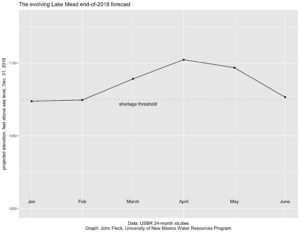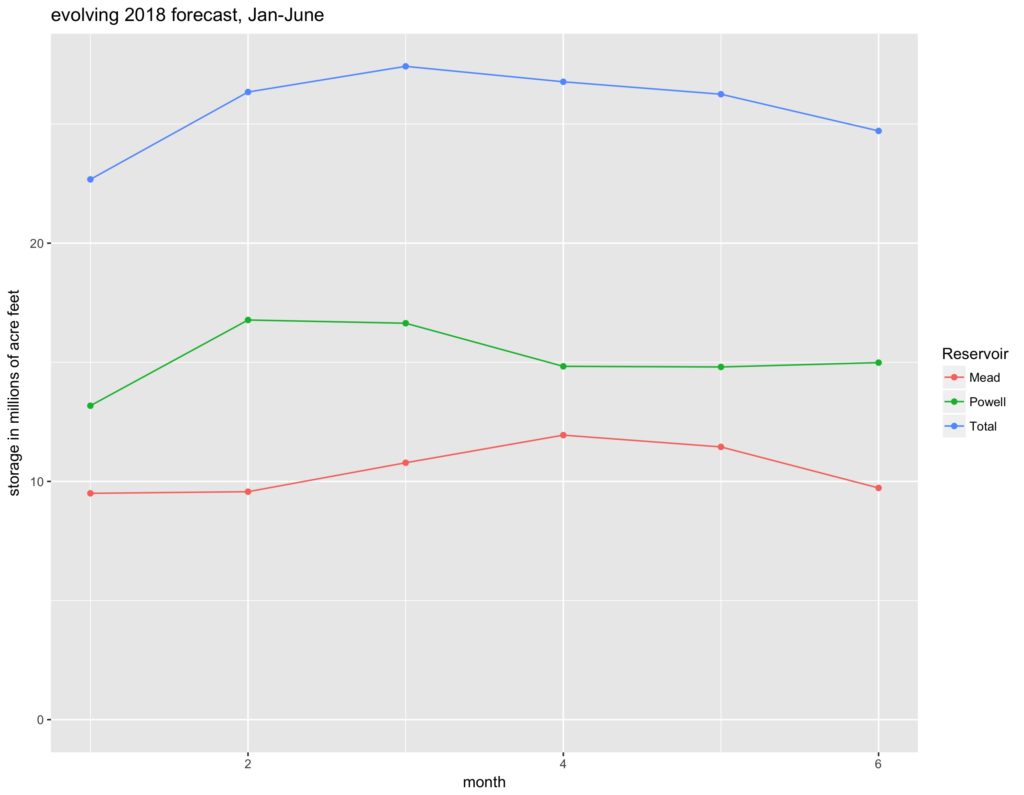The Bureau of Reclamation’s June Colorado River forecast projects Lake Mead ending 2018 at elevation 1,076.5 feet above sea level, three feet higher than the Bureau’s January projection of 1,073.5. If the forecast holds, that’s enough of an increase in Mead storage, thanks to a larger-than average snowpack in the Rockies, to avoid a shortage that will kick in if (when?) the big reservoir serving California, Nevada, and Arizona ends the year below 1,075.
Wait, what?
The latest Bureau of Reclamation Lake Mead forecast triggered a round of headlines in Arizona best exemplified by this: “Lake Mead Predicted to Drop 20 Feet Lower Than Anticipated”.
Holy moly, 20 feet! Which is it, up 3 feet or down 20?
Both.
I wish my data visualization skills were better, I really struggled with coming up with a way to illustrate the numbers. This graph shows the Bureau of Reclamation’s projected Lake Mead median elevation for the end of 2018, as it has evolved over the last six months. So the “Jan” dot is what the projection looked like in January, the “Feb” dot is an update as we got more information about the snowpack and the projection was revised, etc.
Those big bumps in March and April are the forecast models’ response to the big snowpack in the Rockies. But then it got warm and dry, the snow began disappearing, and the forecast began dropping. (As Brad Udall has been pointing out, “warm” does not fully capture what happened. Yes, Brad is right, this is a climate change story.)
I think it’s important to also think, though, about the system as a whole. Here’s a different way of looking at the data – end-of-2018 storage in Mead and Lake Powell as the forecast evolved over the last six months:
Again you can see the forecast for Mead and Powell jumping up with the big snowpack, then dwindling as that potential big runoff turned into actual not-so-big-runoff. But it’s important to note that Lake Mead is still forecast to end 2018 226,000 acre feet above the projection made back in January, and Lake Powell is still projected to end 2018 up 1.8 million acre feet above the January projection. That’s a result of how the rules apportion water between Powell and Mead.
“Losses”, Daniel Kahneman and Amos Tversky wrote, “loom larger than gains.” This is one of the foundational principles of the field of behavioral economics. That’s what’s going on with the headlines. It felt like we had that water, and then we lost it.
But the final numbers are important. This year’s runoff has not been as big as we all hoped, but it was still enough to push projected reservoir levels up.


